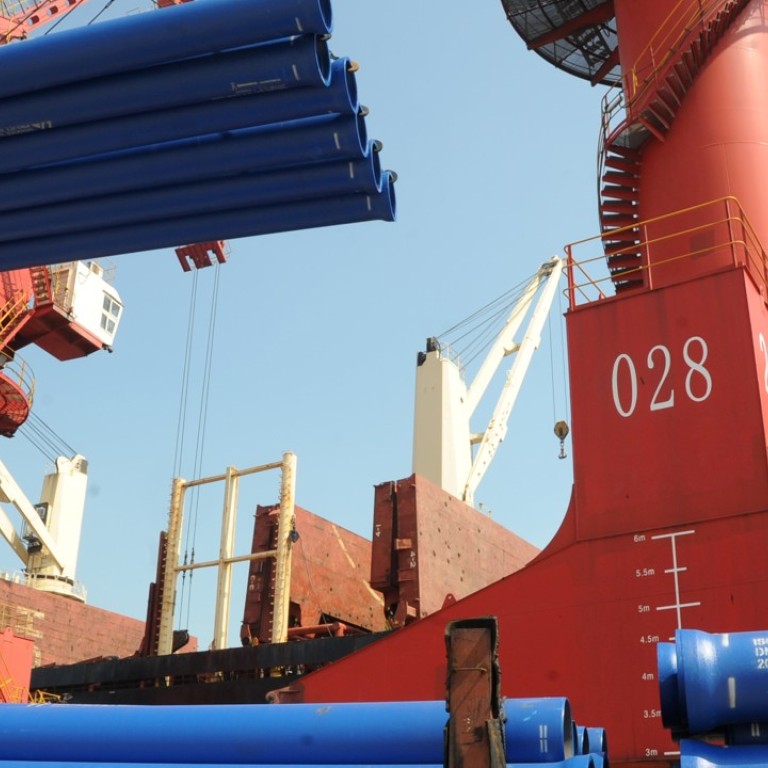
China GDP growth slows to low end of Beijing’s ‘comfort zone’ and Trump may drag it down further
Economy grew 6.7 per cent in second quarter from a year earlier, easing slightly from first quarter, figures show
China’s economy has clung to the lower end of its growth range of the last three years, slowing to 6.7 per cent for the second quarter as exporters brace for bruises from US tariffs.
The rate was down from the 6.8 per cent in the first three months of the year and at the lower end of 6.7-6.9 per cent range posted every quarter since the end of June 2015, according to data released by the National Bureau of Statistics (NBS) on Monday.
But the rate is still within Beijing’s target of “around 6.5 per cent” for the year.
Growth could fall even further if a trade war with the United States escalates.
Various institutions, including Morgan Stanley, forecast that 25 per cent US tariffs on US$50 billion worth of Chinese goods could knock 0.1 percentage points off growth, slowing the economy to its lowest level since the first quarter of 2009 when the country’s exports were hit hard by the global financial crisis.
But if the US goes ahead with threatened 10 per cent duties on another US$200 billion worth of Chinese goods, China’s growth rate could fall by 0.3 percentage points or more, according to various estimates. That would put growth at its lowest level since the aftermath of the Tiananmen crackdown in 1989 when the world’s major economies sanctioned Beijing for its response to the pro-democracy movement.
China reports record trade surplus with US and exports growth in eve of tariffs
For now, China’s slowing growth is mainly the result of an easing in investment spending at home.
Fixed-asset investment, a traditional engine of growth, fell to 6.0 per cent in the first half, the lowest expansion in a decade, NBS data showed.
Factory output grew 6.0 per cent in June from a year earlier, while retail sales rose 9.0 per cent year on year for the same month.
Data on Friday showed China’s exports grew at a solid pace in June, though analysts said this might have been affected by the front-loading of shipments before the tariffs took effect. At the same time, the trade surplus with the US hit a record high last month, adding fuel to Washington’s demands that the gap be narrowed.
Louis Kuijs, chief Asia economist at Oxford Economics in Hong Kong, projected China’s growth to slow to 6.2 per cent in the fourth quarter and 6.1 per cent in 2019 as “growth will be challenged by slow credit growth [at home] and the trade conflict”.
Deutsche Bank chief China economist Zhang Zhiwei said earlier that if US President Donald Trump went ahead with the extra tariffs, it would take 0.3 percentage points off China’s GDP growth.
Zhang forecast growth to slow to 6.6 per cent in the third quarter, 6.5 per cent in the fourth and 6.3 per cent for 2019.
Trump poised to escalate China trade war by publishing US$200 billion hit list of new tariff targets
Zhou Hao, a senior emerging markets economist at Commerzbank in Singapore, said Beijing would face an uphill battle to convince investors that everything would be fine with a China-US trade war.
ING chief Greater China economist Iris Pang said the trade dispute had not yet had a material impact on the Chinese economy, but exporters, together with the long list of upstream and downstream industries, were worried about the row escalating.
Pang said Beijing was expected to fine-tune its policies to keep growth on track, from efforts to boost domestic consumption to further cuts in the required reserve ratio.
Beijing has tried to focus on “quality of growth” instead of headline speed and a moderate slowdown in growth falls into Beijing’s expectations.
It has also been putting on a brave face amid Trump’s trade threats, with central bank adviser Ma Jun, saying the first round of US tariffs would slow China’s growth by 0.2 percentage points and “the impacts have already been basically absorbed”.
NBS spokesman Mao Shengyong said “the external uncertainties are increasing while domestic structural adjustment is on crucial stage” but the impact of a trade war on China’s broad economy would be “should be limited”.
Additional reporting by Reuters

